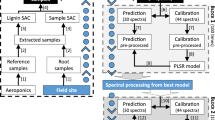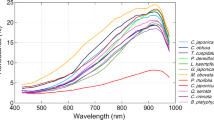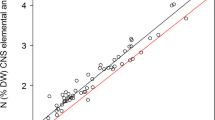Abstract
Assessment of belowground interactions in mixed forests has been largely constrained by the ability to distinguish fine roots of different species. Here, we explored near infrared reflectance spectroscopy (NIRS) to predict the proportion of woody fine roots in mixed samples and analyzed whether the prediction quality of NIRS models is related to the complexity of the fine-root mixture. For model calibration and validation purposes, 11 series of artificial mixed species samples containing known amounts of fine roots of up to four temperate tree species and non-woody plants were prepared. Three types of models with different calibration/validation approaches were developed and tested against external independent data for additional validation. With these models the proportion of each species in root mixtures was predicted accurately with low standard error of prediction (RMSECV/RMSEP <6.5%) and high coefficient of determination (r2 > 0.93) for all fine-root mixtures. In addition, NIRS models also provided satisfactory estimates for samples with low (<15%) or no content of particular components. The predictive power of the NIRS models did not decrease substantially with increasing complexity of the root samples. The approach presented here is a promising alternative to hand sorting of fine roots, which may be influenced substantially by operator variation, and it will facilitate investigating belowground interactions between woody species.



Similar content being viewed by others
References
Bauhus J, Messier C (1999) Soil exploitation strategies of fine roots in different tree species of the southern boreal forest of eastern. Can J For Res 29:260–273. doi:10.1139/cjfr-29-2-260
Bauhus J, Gruselle MC, Nitschke R, Mohammed D, Frischbier N, Khanna PK (2007) The use of Near-Infrared Spectroscopy to study ecological interactions in mixed Norway spruce - European beech forests. In: Xu Z, Johnson CE, Chen C, Blumfield TJ (eds) Linking local management to global change challenges: the proceedings of the international symposium on forest soils and ecosystem health. Noosa, Australia, pp 15–16
Böhm W (1979) Methods of studying root systems. Springer, Berlin
Bolte A, Villanueva I (2006) Interspecific competition impacts on the morphology and distribution of fine roots in European beech (Fagus sylvatica L.) and Norway spruce (Picea abies (L.) Karst.). Eur J Forest Res 125:15–26. doi:10.1007/s10342-005-0075-5
Bruker (2004) Quant OPUS 5.5 Manual. BRUKER OPTIK GmbH, Rudolf-Plank-Str. 27, D-76275 Ettlingen
Brunner I, Brodbeck S, Büchler U, Sperisen C (2001) Molecular identification of fine roots of trees from the Alps: reliable and fast DNA extraction and PCR-RFLP analyses of plastid DNA. Mol Ecol 10:2079–2087. doi:10.1046/ j.1365-294X.2001.01325.x
Cahill JF (2003) Lack of relationship between below-ground competition and allocation to roots in 10 grassland species. J Ecol 91:532–540. doi:10.1046/j.1365-2745.2003.00792.x
Casper BB, Jackson RB (1997) Plant competition underground. Annu Rev Ecol Syst 28:545–570. doi:0066-4162/97/1120-0545
Coleman SW, Barton FE, Meyer RD (1985) The use of NIRS to predict species composition of forage mixtures. Crop Sci 25:834–837
Coleman SW, Christiansen S, Shenk JS (1990) Prediction of botanical composition using NIRS calibrations developed from botanically pure samples. Crop Sci 30:202–207
Cornell JA (1990) Experiments with mixtures: designs, models, and the analysis of mixture data, 2nd edn. Wiley, New York
Diller M (2002) Investigations for the development of a NIRS-method for potatoes in organic farming with special reference to the influence of the year and the potato line. (in German.) Dissertation. Rheinische Friedrich-Wilhelms-Universität, Bonn, Germany
Don A (2007) Carbon dynamics of young experimental afforestations in Thuringia. Dissertation, Eberhard Karls Universität Tübingen, Germany
Foley WJ, McIlwee A, Lawler I, Aragones L, Woolnough AP, Berding N (1998) Ecological applications of near infrared reflectance spectroscopy - a tool for rapid, cost-effective prediction of the composition of plant and animal tissues and aspects of animal performance. Oecologia 116:293–305. doi:10.1007/s004420050591
Guo DL, Xia MX, Wei X, Chang WJ, Liu Y, Wang ZQ (2008) Anatomical traits associated with absorption and mycorrhizal colonization are linked to root branch order in twenty-three Chinese temperate tree species. New Phytol 180:673–683. doi:10.1111/j.1469-8137.2008.02573.x
Hölscher D, Hertel D, Leuschner C, Hottkowitz M (2002) Tree species diversity and soil patchiness in a temperate broad-leaved forest with limited rooting space. Flora 197:118–125. doi:10.1078/0367-2530-00021
Jackson RB, Moore LA, Hoffmann WA, Pockman WT, Linder CR (1999) Ecosystem rooting depth determined with caves and DNA. PNAS USA 96:11387–11392
Leuschner C, Hertel D, Coners H, Büttner V (2001) Root competition between beech and oak: a hypothesis. Oecologia 126:276–284. doi:10.1007/s004420000507
Locher F, Heuwinkel H, Gutser R, Schmidhalter U (2005a) Development of near infrared reflectance spectroscopy calibrations to estimate legume content of multispecies legume–grass mixtures. Agron J 97:11–17
Locher F, Heuwinkel H, Gutser R, Schmidhalter U (2005b) The legume content in multispecies mixtures as estimated with near infrared reflectance spectroscopy: method validation. Agron J 97:18–25
Ludwig B, Nitschke R, Terhoeven-Urselmann T, Michel K, Flessa H (2008) Use of mid-infrared spectroscopy in the diffuse-reflectance mode for the prediction of the composition of organic matter in soil and litter. J Plant Nutr Soil Sci 171:384–391. doi:10.1002/jpln.200700022
Martens HA, Dardenne P (1998) Validation and verification of regression in small data sets. Chemometr Intell Lab Syst 44:99–121. doi:10.1016/S0169-7439(98)00167-1
Meinen C (2008) Fine root dynamics in broad-leaved deciduous forest stands differing in tree species diversity. Dissertation, Georg-August-Universität Göttingen, Göttingen, Germany
Mommer L, Wagemaker CAM, de Kroon H, Ouborg NJ (2008) Unravelling below-ground plant distributions: a real-time polymerase chain reaction method for quantifying species proportions in mixed root samples. Mol Ecol Resour 8:947–953. doi:10.1111/j.1755-0998.2008.02130.x
Moron A, Cozzolino D (2004) Determination of potentially mineralizable nitrogen and nitrogen in particulate organic matter fractions in soil by visible and near-infrared reflectance spectroscopy. J Agric Sci 142:335–343. doi:10.1017/S0021859604004290
Ostonen I, Lohmus K, Lasn R (1999) The role of soil conditions in fine root ecomorphology in Norway spruce (Picea abies (L.) Karst.). Plant Soil 208:283–292. doi:10.1023/A:1004552907597
Petisco C, García-Criado B, Mediavilla S, Vázquez de Aldana BR, Zabalgogeazcoa I, García-Ciudad A (2006) Near-infrared reflectance spectroscopy as a fast and non-destructive tool to predict foliar organic constituents of several woody species. Anal Bioanal Chem 386:1823–1833. doi:10.1007/s00216-006-0816-4
Picon-Cochard C, Pilon R, Revaillot S, Jestin M, Dawson L (2009) Use of near-infrared reflectance spectroscopy to predict the percentage of dead versus living grass roots. Plant Soil 317:309–320. doi:10.1007/s11104-008-9810-2
Pitman WD, Piacitelli CK, Aiken GE, Barton FE (1991) Botanical composition of tropical grass-legume pastures estimated with near-infrared reflectance spectroscopy. Agron J 83:103–107
Pregitzer KS, Deforest JL, Burton AJ, Allen MF, Ruess RW, Hendrick RL (2002) Fine root architecture of nine north American trees. Ecol Monogr 72(2):293–309. doi:10.1890/0012-9615(2002)072[0293:FRAONN]2.0.CO;2
Richardson AD, Reeves BI (2005) Quantitative reflectance spectroscopy as an alternative to traditional wet lab analysis of foliar chemistry near-infrared and mid-infrared calibrations compared. Can J For Res 35:1122–1130. doi:10.1139/x05-037
Roumet C, Picon-Cochard C, Dawson LA, Joffre R, Mayes J, Blanchard A, Brewer MJ (2006) Quantifying species composition in root mixtures using two methods: near-infrared reflectance spectroscopy and plant wax markers. New Phytol 170:631–637. doi:10.1111/j.1469-8137.2006.01698.x
Schenk HJ, Jackson RB (2002) The global biogeography of roots. Ecol Monogr 72:311–328. doi:10.1890/0012-9615(2002)072[0311:TGBOR]2.0.CO;2
Scherer-Lorenzen M, Schulze ED, Don A, Schumacher J, Weller E (2007) Exploring the functional significance of forest diversity: a new long-term experiment with temperate tree species (BIOTREE). Perspect Plant Ecol Evol Syst 9:53–70. doi:10.1016/j.ppees.2007.08.002
Schmid I (2002) The influence of soil type and interspecific competition on the fine root system of Norway spruce and European beech. Basic Appl Ecol 3:339–346. doi:10.1078/1439-1791-00116
Song HY, He Y, Garcia-Pereira A (2005) A new approach to detect soil nutrient content based on NIR Spectroscopy technique. Proceedings of the 2005 IEEE, Engineering in Medicine and Biology 27th Annual Conference, Shanghai, China, September 1–4
Stone M (1974) Cross-validatory choice and assessment of statistical predictions (with discussion). J R Stat Soc B 36:111–147
Wachendorf M, Ingwersen B, Taube F (1999) Prediction of the clover content of red clover- and white clover-grass mixtures by near-infrared reflectance spectroscopy. Grass Forage Sci 54:87–90. doi:10.1046/j.1365-2494.1999.00150.x
Yanai RD, Fisk MC, Fahey TJ, Cleavitt NL, Park BB (2008) Identifying roots of northern hardwood species: patterns with diameter and depth. Can J For Res 38:2862–2869. doi:10.1139/X08-125
Acknowledgements
We are grateful to Julia Sohn, Adam Benneter, Grit Techel and Zhanying Gu for assistance with sample collection. Renate Nitschke and Marie-Cecile Gruselle provided indispensable help on NIRS model development. Many thanks to Michael-Scherer-Lorenzen and Ernst Detlev Schulze for the permission to use the BIOTREE experiment. Pifeng Lei was supported by the German Academic Exchange Service (DAAD). Helpful comments of two reviewers substantially improved the manuscript.
Author information
Authors and Affiliations
Corresponding author
Additional information
Responsible Editor: Hans Lambers.
Rights and permissions
About this article
Cite this article
Lei, P., Bauhus, J. Use of near-infrared reflectance spectroscopy to predict species composition in tree fine-root mixtures. Plant Soil 333, 93–103 (2010). https://doi.org/10.1007/s11104-010-0325-2
Received:
Accepted:
Published:
Issue Date:
DOI: https://doi.org/10.1007/s11104-010-0325-2




